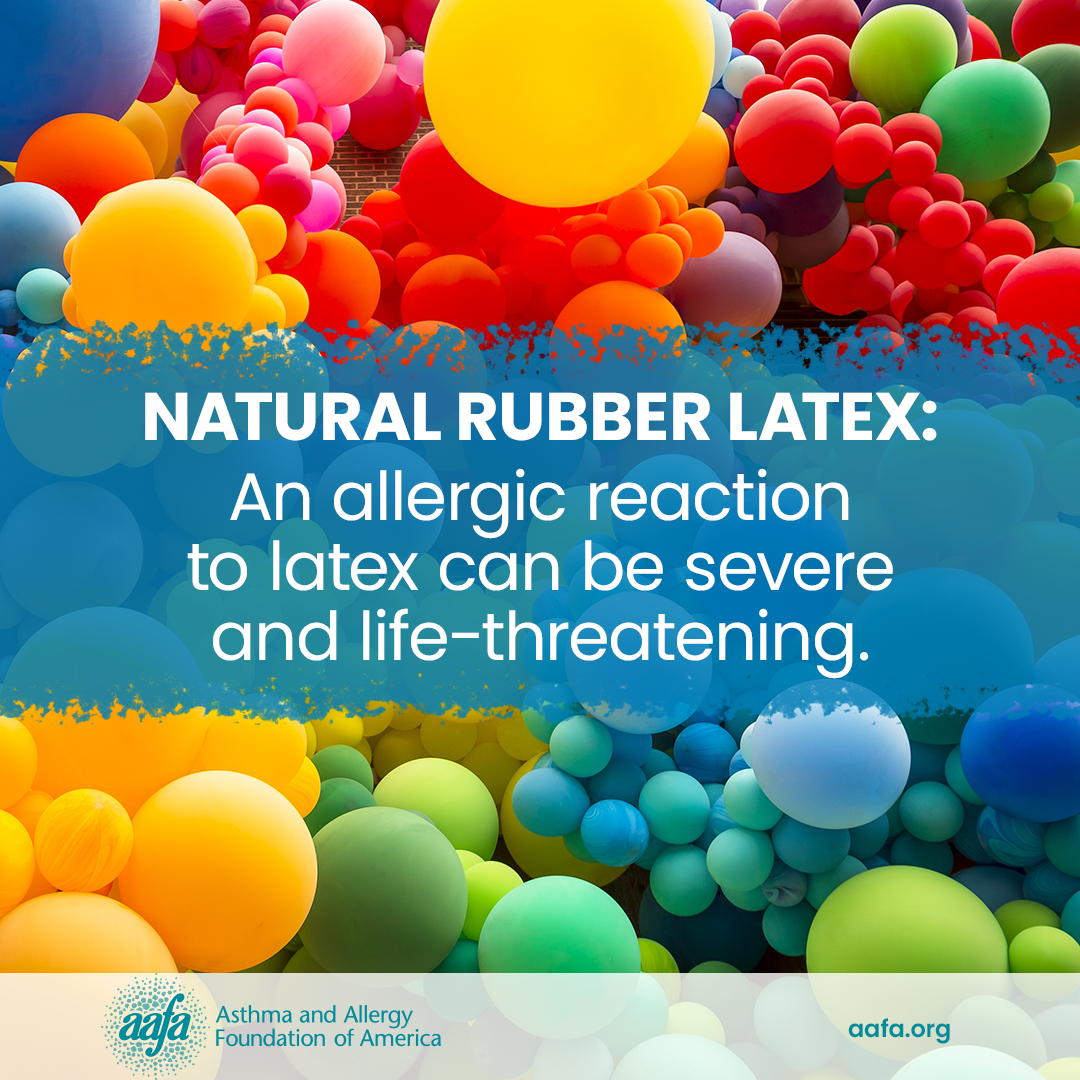Allergies
Latex Allergy
Many everyday products contain latex, such as:
- Balloons
- Erasers
- Condoms and diaphragms
- Rubber household gloves
- Medical gloves
- Catheters
- Dental products (wedges, orthodontic rubber bands)
- Elastic in clothing
- Rubber balls
- Bandages (adhesives)
- Foam mattresses and pillows
- Rubber bands (minor source)
This is just a small number of items that may contain latex.
If you have a latex allergy, you may have an allergic reaction if you come in contact with latex. You may come into contact in different ways. You may have allergic reactions by breathing in latex fibers in the air. You can have allergic reactions if latex touches your skin. You may have an allergic reaction to some fruits that cross-react with latex.
Synthetic latex, found in latex paint, does not come from the sap of a rubber tree. Synthetic latex does not cause latex allergy symptoms.
How Do Doctors Diagnose a Latex Allergy?
If you think you may be allergic to latex, see a board-certified allergist to confirm the allergy. To diagnose a latex allergy, the doctor will ask you about your medical history and do a physical exam. If they think you have a latex allergy, they may order an allergy skin test or blood test. Your doctor will compare your test results with your history and physical exam to diagnose a latex allergy.
What Are the Types of Latex Reactions?
There are two main types of reactions to natural rubber latex:
- Immunoglobulin E (IgE) mediated (classic immediate allergic reaction)
- Contact dermatitis (delayed allergic reaction)
If you have any type of allergic reaction to latex, you should avoid it.
IgE-Mediated Latex Allergy
An IgE-mediated latex allergy is an allergy to natural rubber latex proteins. Your body’s immune system makes specific antibodies called IgE antibodies. These antibodies react with latex proteins and cause allergy symptoms.
An allergic reaction can occur when latex:
- Touches your skin
- Comes in contact with a mucous membrane, such as your mouth
- Gets into your lungs when you breathe in latex particles
IgE allergic reactions to latex can cause a severe allergic reaction called anaphylaxis [anna-fih-LACK-sis].
Contact Dermatitis
Dermatitis means skin inflammation. There are two types of contact dermatitis that can occur with a latex allergy:
- Allergic contact dermatitis
- Irritant contact dermatitis
Allergic contact dermatitis is a type of allergy to chemicals used to make latex. This is not a reaction to rubber proteins. It usually does not cause anaphylaxis.
These chemicals can cause contact dermatitis 24 to 48 hours after exposure. This type of dermatitis can spread to other areas of your body, if touched. Symptoms usually go away spontaneously, but you may need medical treatment if they continue.
Irritant contact dermatitis is a common reaction to natural rubber latex, but it is not an allergy. Irritant contact dermatitis is a red, itchy rash that breaks out where latex has touched your skin. It appears 12 to 24 hours after contact.
Irritant contact dermatitis can be the result of:
- Frequent handwashing and incomplete drying
- Use of hand sanitizers
- Friction irritation from glove powder
Many people who develop an IgE-mediated latex allergy will have contact dermatitis first. If you have contact dermatitis to latex, it may be a warning that you could develop a latex allergy later. Talk with your allergist if contact with latex and products that contain latex cause you to have contact dermatitis.
What Are the Symptoms of a Latex Allergy?
You may have some early symptoms after you have contact with latex items, such as:
- Itchy or swollen lips after blowing up a balloon
- Itchy, red, or swollen skin after using a bandage and/or latex gloves
- Swelling or itching of the mouth or tongue after a dentist uses latex gloves
- Itching or swelling after vaginal or rectal exams
- Itching or swelling after using a condom or diaphragm
If you are highly allergic to latex, you may have severe reactions from contact with latex. You may even react to a small amount of latex in the air, such as being in a room near latex balloons or gloves. These more severe reactions can include:
- Hives
- Itching
- Swelling
- Runny nose or sneezing
- Inflammation of the eyes
- Breathing problems including asthma symptoms
- Anaphylaxis
Anaphylaxis can be serious. It can even cause death.
Do not ignore symptoms that suggest you may be allergic to latex. Continued contact with latex products can lead to more severe reactions. Repeated exposure to latex may lead to chronic conditions like work-related (occupational) asthma.
Who Is Likely to Have a Latex Allergy?
Certain groups of people tend to have a greater risk of developing a latex allergy. These groups include:
- People who have had many surgeries or medical procedures – for example, children with spina bifida or people who frequently use catheters containing latex
- Health care workers and other people who often wear latex gloves (for example, food handlers/restaurant workers, hairdressers, security personnel, first responders, and painters)
- People with other allergies, such as allergic rhinitis (hay fever) and food allergies
New cases of latex allergy aren’t as common now. Rates were higher in the 1980s and ‘90s when health care workers used latex products more often. Now many health care facilities use non-latex gloves and products.
How Can I Prevent Allergic Reactions to Latex?
If you have a latex allergy, work with your doctor to learn how to recognize symptoms of an allergic reaction and how to treat it.
- Avoid latex. The only treatment for a latex allergy is to prevent any contact with latex products.
- Ask coworkers to wear only non-latex gloves.
- Ask doctors, dentists, and other health care workers to use latex-free gloves and products.
- Check labels to make sure products do not contain latex. Do not assume hypoallergenic products are latex free.
- Ask your doctor for a written anaphylaxis action plan. This gives you steps on what to do in an emergency.
- Learn how to use an epinephrine auto-injector. This medicine is the first line of treatment for an allergic reaction or anaphylaxis. Epinephrine is safe. After using an epinephrine auto-injector, immediately call 911 and seek medical care.
- Have epinephrine with you at all times.
- Teach people who spend time with you how to use the auto-injector device.
- Wear a medical alert ID or jewelry so other people, such as first responders or health care workers, know you have a latex allergy in an emergency.
Are Latex and Food Allergies Related?
Some foods have proteins that are like the proteins in rubber tree sap. If you have a latex allergy, you may have reactions to some foods. This is called “latex-fruit syndrome” or “latex-food allergy syndrome.” About 30 to 50% of people with a latex allergy have latex-fruit syndrome.1
Here are some of the foods you may react to if you have a latex allergy:
- Most common:
- Avocado
- Banana
- Bell pepper
- Chestnut
- Fig
- Kiwi
- Peach
- Tomato
- Less common:
- Apricot
- Celery
- Coconut
- Mango
- Papaya
- Passion fruit
- Pineapple
- Spinach
- Strawberry
Medical Review: July 2022 by John James, MD
References
1. Parisi, C. A. S., Kelly, K. J., Ansotegui, I. J., Gonzalez-Díaz, S. N., Bilò, M. B., Cardona, V., Park, H.-S., Braschi, M. C., Macias-Weinmann, A., Piga, M. A., Acuña-Ortega, N., Sánchez-Borges, M., & Yañez, A. (2021). Update on latex allergy: New insights into an old problem. The World Allergy Organization Journal, 14(8), 100569. https://doi.org/10.1016/j.waojou.2021.100569
Allergy Capitals
Your location can have an impact on your seasonal allergies. AAFA’s Allergy Capitals™ report looks at the top 100 most challenging cities in the continental United States to live with seasonal pollen allergies.














